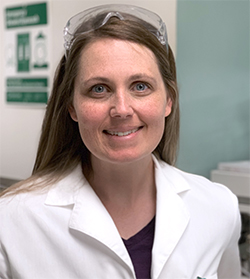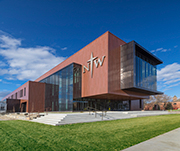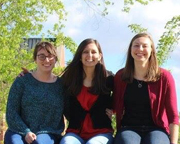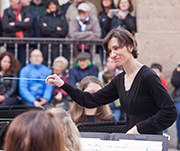A Scientist Marvels at God’s Creation
BY SARAH WYNIA-SMITH ’03

BRIAN SMITH
“Oh, WOW! Look at that! I can see the DNA!” It was the spring of 2001 at NWC. I was a sophomore biology major in the laboratory of Dr. Sara Sybesma ’84 Tolsma’s genetics course. For the first time, I was using equipment that enables a scientist to gaze upon and even print a picture of DNA fragments.
In the same way that I’ve felt overwhelmed when marveling upon vast stretches of God’s creation at places like Yosemite National Park, I felt my heart leap at just how amazing it was that our bodies are controlled by DNA, knit together by God. I remember returning to my dorm room and proudly affixing that DNA picture to the door, very excitedly explaining it to anybody who would listen.
With my interest in biology, I’d entered college aiming to become a physician. However, in observing my professors, I secretly wished I could join their ranks. All I needed was a nudge. One day in that same genetics course, Dr. Tolsma overheard me explaining a theory to a fellow student. She exclaimed, “Sarah, you are a natural at this!” I returned to my experiment but later pressed her on what she meant. That started a discussion about shifting my goal from becoming a physician to earning a Ph.D. and embarking upon a career in scientific research and education.
To sharpen my research skills, I completed internships at the University of North Carolina and also at NWC in Dr. Ralph Davis’ lab. He was new at NWC after many years as a research scientist at the University of Wisconsin-Madison. As he mentored me in the art of dissecting parasitic worms to measure miniscule cellular electric currents, he also mentored me on how to see the laboratory as a sacred place where I could marvel at the goodness of God’s creation.
Dr. Davis even accurately predicted what might happen in the following years as I looked forward to entering a Ph.D. program in physiology at his former institution: “Maybe you’ll meet another young scientist at graduate school, fall in love, and the two of you could be like [Nobel Prize-winning scientists] the Curies, running your own lab together!”
For the next several years, I weathered the significant peaks and valleys that are often part of the Ph.D. experience. Earning a doctorate includes producing a dissertation, a body of original research work. In the sciences, one joins a research lab group and learns to design, perform and publish experiments. The first three years of my research yielded nothing but dead ends. Coupled with some more personal challenges, the experience was utterly demoralizing. On multiple occasions, I thought about quitting.
I was so fortunate I made it a priority to find a Christian community. I found a family-away-from-family to cry with and deepen my spiritual roots in the community at Geneva Campus Church. Likewise, I bonded with fellow Christian graduate students in the ministry sponsored by InterVarsity Christian Fellowship and dove deep into the challenges of living out one’s faith in secular academia.
It was at an InterVarsity meeting that I met my future husband, Brian. He was working on a Ph.D. in organic chemistry, and like myself, was a worship leader. After many years in the “friend zone,” we married in 2007. In 2009, both having earned our doctorates, we became postdoctoral researchers.
Through somewhat unique circumstances, we eventually ended up working in the same laboratory. I remembered Dr. Davis’ prediction that I might set up a lab someday with my future spouse, and this was the opportunity to give that a test drive. As it turns out, we are very complementary in our approach to science. It was clear we could work together quite well and, moreover, that we were being called to start our own laboratory together.
In 2014, we moved to the Milwaukee area to start our laboratory at the Medical College of Wisconsin. Along with a fantastic group of Ph.D. students, medical students, undergraduate interns, postdoctoral researchers and laboratory technicians, we investigate some of the molecular pathways involved in diseases such as cancer, heart disease, neurodegeneration and diabetes. As I mentor students today, I still draw on what I learned from my professors at NWC and channel that “Oh, WOW!” in reference to the amazing invisible molecular world God created under all that is visible.
Dr. Sarah Wynia-Smith graduated from NWC with a major in biology and a minor in chemistry. She earned a Ph.D. in physiology from the University of Wisconsin-Madison in 2009 and did post-doctoral biochemistry research at the University of California-Berkeley and The Scripps Research Institute.
 The 61,000 square-foot
DeWitt Family Science Center features large windows to the outdoors and into classrooms and laboratories, making a grand impression on the southwest entrance to campus.
The 61,000 square-foot
DeWitt Family Science Center features large windows to the outdoors and into classrooms and laboratories, making a grand impression on the southwest entrance to campus. Friendships formed at Northwestern—whether begun at a freshman wing meeting, in a dorm room or at a play rehearsal—often last a lifetime.
Friendships formed at Northwestern—whether begun at a freshman wing meeting, in a dorm room or at a play rehearsal—often last a lifetime. Northwestern’s Symphonic Band presented eight concerts in eight days during a spring break mission tour of Spain.
Northwestern’s Symphonic Band presented eight concerts in eight days during a spring break mission tour of Spain. Due largely to the excellence, commitment and inspiration of longtime faculty, North-western’s science programs earned an exceptional reputation despite operating in modest facilities.
Due largely to the excellence, commitment and inspiration of longtime faculty, North-western’s science programs earned an exceptional reputation despite operating in modest facilities.
Classic Comments
All comments are moderated and need approval from the moderator before they are posted. Comments that include profanity, or personal attacks, or antisocial behavior such as "spamming" or other inappropriate comments or material will be removed from the site. We will take steps to block users who violate any of our terms of use. You are fully responsible for the content that you post. Comments posted do not reflect the views or values of Northwestern College.